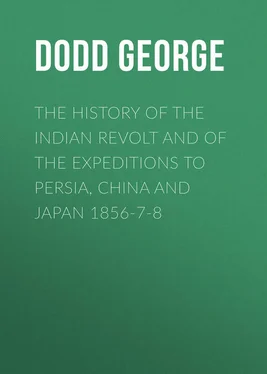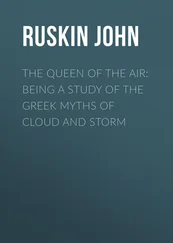George Dodd - The History of the Indian Revolt and of the Expeditions to Persia, China and Japan 1856-7-8
Здесь есть возможность читать онлайн «George Dodd - The History of the Indian Revolt and of the Expeditions to Persia, China and Japan 1856-7-8» — ознакомительный отрывок электронной книги совершенно бесплатно, а после прочтения отрывка купить полную версию. В некоторых случаях можно слушать аудио, скачать через торрент в формате fb2 и присутствует краткое содержание. Жанр: foreign_antique, foreign_prose, на английском языке. Описание произведения, (предисловие) а так же отзывы посетителей доступны на портале библиотеки ЛибКат.
- Название:The History of the Indian Revolt and of the Expeditions to Persia, China and Japan 1856-7-8
- Автор:
- Жанр:
- Год:неизвестен
- ISBN:нет данных
- Рейтинг книги:3 / 5. Голосов: 1
-
Избранное:Добавить в избранное
- Отзывы:
-
Ваша оценка:
- 60
- 1
- 2
- 3
- 4
- 5
The History of the Indian Revolt and of the Expeditions to Persia, China and Japan 1856-7-8: краткое содержание, описание и аннотация
Предлагаем к чтению аннотацию, описание, краткое содержание или предисловие (зависит от того, что написал сам автор книги «The History of the Indian Revolt and of the Expeditions to Persia, China and Japan 1856-7-8»). Если вы не нашли необходимую информацию о книге — напишите в комментариях, мы постараемся отыскать её.
The History of the Indian Revolt and of the Expeditions to Persia, China and Japan 1856-7-8 — читать онлайн ознакомительный отрывок
Ниже представлен текст книги, разбитый по страницам. Система сохранения места последней прочитанной страницы, позволяет с удобством читать онлайн бесплатно книгу «The History of the Indian Revolt and of the Expeditions to Persia, China and Japan 1856-7-8», без необходимости каждый раз заново искать на чём Вы остановились. Поставьте закладку, и сможете в любой момент перейти на страницу, на которой закончили чтение.
Интервал:
Закладка:
Lower Bengal, or the Lower Provinces of Bengal, considered as a sub-presidency or lieutenant-government, comprises all the eastern portion of British India, bounded on the east by the Burmese and Chinese Empires, and on the north by Nepaul, Sikim, and Bhotan; southward, it is washed by the Bay of Bengal; while inland or westward, it reaches to a point on the Ganges a little beyond Patna, but not so far as Benares. Fancy might compare it in shape to a dumb-bell, surmounting the upper part of the Bay of Bengal, which washes its shores throughout a distance of 900 miles. Without reckoning native states under the control of the Company, this lieutenant-governorship is considerably more than three times as large as England and Wales; and nearly the whole of it is in the basins of, or drained by, the two magnificent rivers Ganges and Brahmaputra. On the principle before adopted, we give the names of districts most likely to become familiarised to the reader – Jessore, Burdwan, Bancorah, Bhaugulpore, Monghir, Cuttack, Balasore, Midnapore, Moorshedabad, Rungpoor, Dacca, Silhet, Patna, Bahar, Chittagong, the Sunderbunds, Assam, Aracan. Most of these are also the names of towns, each the chief in its district; but there are other important towns and places not here named – including Calcutta, Cossimbazar, Barrackpore, Chandernagore, Serampore, Culpee, Purneah, Boglipore, Rajmahal, Nagore, Raneegunge, Jellasore, Dinapore, Bahar, Ramghur, Burhampore.
Northwest Bengal, or the Northwestern Provinces of the Bengal presidency, regarded as a sub-presidency or lieutenant-governorship, comprises some of the most important and densely populated districts of Northern India. It covers seven degrees of latitude and nine of longitude; or, if the portion of the ‘non-regulation’ districts under the control of this lieutenant-governor be included, the range extends to ten degrees of latitude and twelve of longitude. Its boundary is roughly marked by the neighbouring provinces or states of Sirhind, Kumaon, Nepaul, Oude, Lower Bengal, Rewah, Bundelcund, and Scindiah’s Mahratta territory; but many of these are included among its ‘non-regulation’ territories. In its limited, strictly British territory, it is a little larger than England and Wales; but including the ‘non-regulation’ provinces, such as Kumaon, Ajmeer, Saugor, &c., it is vastly larger. As the chief city is Agra, the lieutenant-governorship is often called by that name: more convenient, perhaps, than the one officially adopted – indeed it was at one time determined, though the plan has been postponed sine die , to form an entirely new and distinct presidency, called the Presidency of Agra. The Ganges and the Jumna are the great rivers that permeate it. As before, we give the names of the most familiarly known divisions or districts – Delhi, Meerut, Allygurh, Rohilcund, Bareilly, Shahjehanpoor, Bijnour, Agra, Furruckabad, Allahabad, Cawnpore, Futtehpore, Benares, Gorukhpore, Azimghur, Jounpore, Mirzapore, Ghazeepore; and if to these we add the names of towns not indicated by the names of their districts – such as Simla, Sirhind, Umballa, Loodianah, Shahabad, Buxar – it will be seen how many places noted more or less in Indian affairs lie within this province or lieutenant-governorship.
For the sake of brevity, it may here be remarked, we shall frequently, in future chapters, use the names ‘Northwest Bengal’ and ‘Lower Bengal,’ instead of the tedious designations ‘Northwestern Provinces’ and ‘Lieutenant Government of Bengal.’
As to the fifth or remaining sphere of government – that which is under the governor-general himself – it is with difficulty described; so many are the detached scraps and patches. The overworked representative of the crown, whether his name be Auckland or Ellenborough, Dalhousie or Canning, finding the governorship of Bengal too onerous when added to the governor-generalship of the whole of India, gives up his special care of Bengal, divides it into two sub-provinces, and hands it over to the two lieutenant-governors. But the increase of territory in British India has been so vast within the last few years, and the difficulty so great of deciding to which presidency they ought to belong, that they have been made into a fifth dominion or government, under the governor-general himself. The great and important country of the Punjaub, acquired a few years ago, is one of the list; it is under the governor-general, and is administered for him by a board of commissioners. The kingdom of Oude is another, annexed in 1856, and similarly represented by residents or commissioners acting for and under the orders of the governor-general. The province of Nagpoor is a third: a large country in the very centre of India, annexed in 1853, and nearly touching all the four governorships already described. Pegu is a fourth, wrested from the sultan of Burmah, in 1852, and placed under the governor-general’s administration. A fifth is Tenasserim, a strip of country stretching five hundred miles along the eastern shore of the Bay of Bengal. There are other fragments; but the above will suffice to shew that the governor-general has no inconsiderable amount of territory under his immediate control, represented by his commissioners. If we look at the names of places included within these limits, we shall be struck with their number and importance in connection with stirring events in India. In the Punjaub we find Peshawur, Attock, Rawul Pindee, Jelum, Ramnugur, Chillianwalla, Wuzeerabad, Umritsir, Lahore, Jullundur, Ghoorka, Ferozpore, Ferozshah, Moodkee; in the once independent but now British province or kingdom of Oude will be found the names of Lucknow, Oude, Fyzabad, Sultanpore, Khyrabad; in the territory of Nagpoor is the town of the same name, but other towns of any note are scarce. In Pegu and Tenasserim, both ultra-Gangetic or eastward of the Ganges, we find Rangoon, Bassein, Prome, Moulmein, and Martaban.
The reader has here before him about a hundred and forty names of places in this rapid sketch of the great divisional governments of India, mostly the names of important towns; and – without any present details concerning modes of government, or numbers governed, natural wealth or social condition – we believe he will find his comprehension of the events of the great Revolt much aided by a little attention to this account of the five governments into which British India is at present divided. As for the original names of kingdoms and provinces, nawabships and rajahships, it scarcely repays the trouble to learn them: when the native chiefs were made pensioned puppets, the former names of their possessions became of lessened value, and many of them are gradually disappearing from the maps. We have ‘political residents,’ ‘government agents,’ or ‘commissioners,’ at the capital city of almost every prince in India; to denote that, though the prince may hold the trappings of royalty, there is a watchful master scrutinising his proceedings, and claiming something to do with his military forces. Such is the case at Hyderabad in the Nizam’s territory, at Khatmandoo in Nepaul, at Gwalior in Scindiah’s dominions, at Indore in Holkar’s dominions, at Bhopal, in the country of the same name, at Bhurtpore and elsewhere in the Rajpoot princes’ dominions, at Darjeeling in Sikim, at Baroda in the Guicowar’s dominions, &c.
The semi-independent princes of India – mostly rajahs if Hindoos, nawabs if Mohammedans – are certainly placed in a most anomalous position. There are nearly two hundred of these vassal-kings, if we may so term them – some owning territories as large as European kingdoms, while others claim dominion over bits of country not larger than petty German principalities. The whole of them have treaties and engagements with the British government, involving the reciprocal obligations of protection and allegiance. Some of them pay tribute, others do not; but almost all have formally relinquished the right of self-defence, and also that of maintaining diplomatic relations with each other. The princes are regarded as children, expected to look up for protection only to their great mother, the Company. The Company undertakes not only to guarantee external safety but also internal tranquillity in these states, and is the umpire in all quarrels between native rulers. Though not called upon, and indeed not allowed, to defend themselves from an external attack, the princes mostly have armies, more for show than use under ordinary circumstances; but then they must obtain permission to do this, and they must limit the numbers; and in some cases there is a stipulation that if the British be at war in India, the prince must lend his troops. It is in this sense that the independent princes of India are said to possess, collectively, an armed force of little less than four hundred thousand men: many of them available, according to treaty, for British service.
Читать дальшеИнтервал:
Закладка:
Похожие книги на «The History of the Indian Revolt and of the Expeditions to Persia, China and Japan 1856-7-8»
Представляем Вашему вниманию похожие книги на «The History of the Indian Revolt and of the Expeditions to Persia, China and Japan 1856-7-8» списком для выбора. Мы отобрали схожую по названию и смыслу литературу в надежде предоставить читателям больше вариантов отыскать новые, интересные, ещё непрочитанные произведения.
Обсуждение, отзывы о книге «The History of the Indian Revolt and of the Expeditions to Persia, China and Japan 1856-7-8» и просто собственные мнения читателей. Оставьте ваши комментарии, напишите, что Вы думаете о произведении, его смысле или главных героях. Укажите что конкретно понравилось, а что нет, и почему Вы так считаете.












